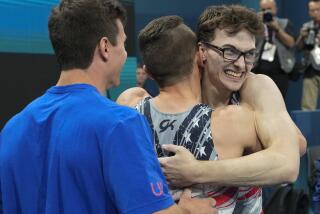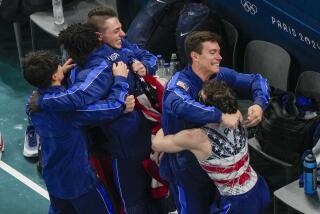Keswick’s Comeback No Rip-Off
- Share via
He was this 8-year-old kid from Las Vegas who first got interested in gymnastics in . . . Iran? There were trampolines for the children of the military personnel to play on, and Scott Keswick’s father, stationed there with the U.S. Air Force in the tension-filled late ‘70s, was glad that his little boy had found something to keep him occupied.
Keswick really got the hang of it. Back in the States, he caught Kurt Thomas’ act at the 1984 L.A. Olympics on television and knew that’s what he wanted to do. Within a year, he had made the national juniors at Columbus, Ohio, and by 1989 was winning the first of his four U.S. championships on the still rings, by then having enrolled at UCLA.
When he fell, he fell hard.
Just back from the Goodwill Games in Russia and getting ready for the Pan American Games about to be held in Argentina in early 1995, Keswick was doing his dismount at a competition in Seattle when he “ripped off” the high bar, gymnast lingo for losing his grip. How badly he was hurt wasn’t obvious at first, but Scott soon became painfully aware that the Summer Olympics of 1992, where he represented his country, would be his last.
“I just wanted to get my life back,” he says.
The pain became excruciating a few months after the accident. Months of physical therapy had made surgery unnecessary, but then Keswick made the mistake of taking a five-hour car trip up the California coast. The back pain flared up overnight. It was unbearable.
His operation last July was one that makes listeners wince, whenever they hear it described. Four screws and two rods were inserted in Keswick’s back. Bone had to be grafted from the pelvis. He had a herniated disk and instability in the vertebrae, and the spine had to be fused.
The doctor who did the surgery, Rick Delamarter of the UCLA medical center, says, “Scott’s spine started to dislocate, so we really had no choice. It’s the sort of thing more frequently necessary for older people.
“We took out the herniated disk and placed in pedicle screws, with small titanium rods. It was kind of like an internal cast. Any type of athlete would have had good reason to believe his career was in jeopardy at that point. Scott certainly thought so. I think we all did.”
Yes, Scott thought so.
He had been hurt before. It is the nature of his sport. Once, he broke his leg and had it put in a steel-encased cast. But this, this pain was at the very center of his being.
That’s why even someone as generally optimistic as Keswick freely admits that the 1996 Olympics were over for him at that point, because, “I thought I was retired. I had to be. I was literally disabled.”
He wore a full upper-body brace for three months. Therapists would let him out of bed 15 minutes at a time. Only rarely did Keswick get to step outside and breathe some fresh air.
Immobilized that way, he had a lot of time to think about what went wrong.
“To this day, I don’t consider that I made a mistake,” he says. “I don’t know what happened. I’ve never in 18 years ripped off the bar that way. It never happened to me before and it’ll never happen again.”
He had one thing going for him; being in such great shape. No, two things. The willpower to fight was a definite factor. Three months into his rehabilitation, Keswick was bugging his doctors by doing more than they had prescribed for him to do.
Delamarter says, “I had to hold him back.”
Having expected to retire after winning his fourth national championship on rings in 1994, something no other gymnast has done, Keswick was more eager to walk again than to compete. But his old instincts kicked in. He had placed 19th in the all-around competition at Barcelona. The next Olympics would be in his homeland. To begin in Iran and end up in the U.S., what an apt way for a gymnast to come full circle.
Keswick, 26, will be one of 14 men bidding for the U.S. team at the Olympic trials in Boston, beginning Thursday. He says he never felt better in his life.
More to Read
Go beyond the scoreboard
Get the latest on L.A.'s teams in the daily Sports Report newsletter.
You may occasionally receive promotional content from the Los Angeles Times.






